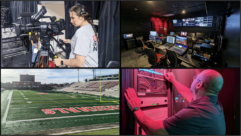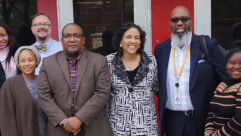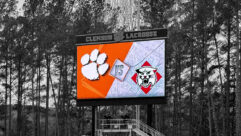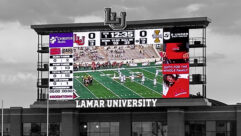
The Buzz: Install of the Month:
Hofstra University, Hempstead, N.Y.
Sep 1, 2006 12:00 PM
Collegiate Fiber
Hofstra University’s world-renowned School of Communications features one of the largest non-commercial radio and television broadcast facilities on the East Coast. When former President Bill Clinton addressed thousands of attendees at the University Cultural Center’s 11th Presidential Conference earlier this year, school officials wanted to provide campus-wide television coverage of the event. To make that happen, video engineers at the school installed an all-digital fiber-optic transmission system for composite video, with four audio channels, at the School of Communications.

For campus-wide television broadcasting, Hofstra University’s video engineering team installed Pure Digital Fiberlink 3400 Series transmitters/receivers in wall-mounted
I/O enclosures around campus.
Under supervision of chief engineer Joe Valerio, Hofstra video engineers Joe Giordano and Victor Lazo — who normally maintain the school’s two television studios, ancillary equipment, and 29 Avid editing rooms — spearheaded the installation. The team’s days usually revolve around repairing equipment, troubleshooting problems, and providing engineering support to students working on television and editing projects.
Prior to installing the new digital fiber system, the university had only one analog fiber transmitter/receiver that it routinely shuffled between four sites around campus as needed. Staff and students had to schedule their time with the gear in advance, and it normally took two engineers — one at the transmit site and one back at the studio’s technical hub — to set it up and calibrate everything. After the gear was used, that same staff then had to go back and retrieve the transmitter for use at another site, and then set it up and recalibrate all over again. Students would occasionally use the analog gear for news shows, transmitting live from remote sites such as the basketball arena.
While the signal quality of that system was passable — “About 75 or 80 percent” of the original source quality, according to Giordano — Hofstra’s engineers knew there were better options.
“In early 2005, we proposed purchasing four transmitter/receivers and permanently installing them at the existing sites, but we wanted something that didn’t need constant calibration and maintenance,” Giordano says. The proposal was well-received by the departments that would be using the gear (School of Communications, Sports, and Special Events), but the cost was slightly higher than what the university wanted to spend.
“The proposal was filed away, but not forgotten,” Giordano says. “But in September 2005, the university decided to provide campus-wide television coverage of the upcoming Clinton Presidential Conference, and the fiber project was not only revived, but expanded — and, this time, approved.”
The team at Hofstra was looking for a system that featured a compact transmitter design for easy wall-mounting, rackmountable receiver trays, high-quality workmanship, and high signal quality. “CSI’s Pure Digital Fiberlink products met all of our needs,” Giordano says, “so we borrowed a transmitter/receiver over the summer and tested it in our existing fiber venues. We were quickly impressed with the excellent video and audio signal quality, and how effortless it was to set up.”
After the project was approved, Hofstra engineers worked closely with CSI officials to ensure on-time delivery. The school chose 3400 Series transmitters/receivers from the Pure Digital Fiberlink line to handle composite video and stereo audio transmission.
Giordano says the basic installation of the technology was simple for the Hofstra engineers. “We mounted the transmitters in a wall-mounted input/output enclosure and pre-wired the video and audio inputs to a custom-designed front panel fabricated by PanelCrafters [Liberty Wire & Cable] to our specifications,” he says. “We made 10 enclosures and mounted them in closets and on walls at the various venues around campus.” The enclosures host connectors and power switches and are designed to make it easy for students to output a signal.
In terms of the fiber infrastructure, four lines existed already. The telecom department at Hofstra installed lines to six new transmitter locations, using 12 pairs of fibers (enclosed in one cable) dedicated for AV transmission. The six new fiber locations were patched in from this main line. Back at the Technical Operations Center, engineers rackmounted the receivers in a Pure Digital Fiberlink card cage and connected the video and audio outputs to patch panels that feed the routing switcher. The system was completed two weeks before the Presidential Conference started.
“With a digital system, the engineers don’t have to calibrate a fiber path every time it’s used. What goes in comes out,” Giordano explains. “When a team wants to broadcast from a site, they just go to one of the video/audio input panels we designed and mounted at the sites, power up the fiber, plug in their cables, and give us a call. We confirm their signal and route it to a TV channel or videotape recorder. The signal comes back to our Technical Operations Center and is sent out over the campus TV network. With 10 sites now online, we have a genuine fiber transmission network that will last for years.” The center controls the four campus TV channels.
Giordano says that during the Clinton conference, faculty members commented on the crispness and clarity of the pictures from the remote sites. “We were also impressed with the audio quality,” he adds. “One change I would like to see is the addition of some sort of front-panel monitoring connections on the receiver — especially on the rackmount version.”
Beyond that particular event, Giordano says the system is now aiding the communications students’ education. In May, for instance, the School of Communications transmitted Hofstra’s graduation ceremonies live to the campus TV network from the outdoor stadium. A backup camera was set up in the basketball arena in case of rain. Both venues have a permanent fiber link.
“Our students do live remotes from the sports venues as part of their television production curriculum, and the new system makes that immensely easier,” he says. “Having 10 venues permanently wired gives the university a resource they never had before. With some additional fiber paths, it’s conceivable that a live broadcast can originate from our studios someday.
“With the new system,” Giordano continues, “we can now do more with our existing television equipment than ever before. From a student’s perspective, they can use broadcast-grade equipment right up the line, from studio and portable cameras to routers and transmission systems. From an engineer’s perspective, anything that works easily and seamlessly is a dream — especially these days.”
Subscribe to Sound & Video Contractor e-newsletters!
Sound & Video Contractor EXTRA
Systems Integration Special Focus series:
Houses of Worship
Corporate AV
Residential AV
AV Over Fiber
AV in Education
Breaking industry news in your email inbox every other week! Subscribe at www.svconline.com.










